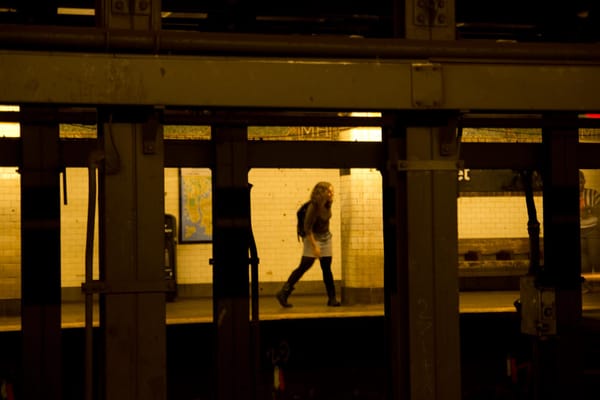All roads lead to...Reykjavik?

Since humans began to move around on the planet, travel has always been a business. Whether it was providing lodging for passing shepherds, selling shards of supposedly holy wood to pilgrims, or cooking for soldiers on the sides of Roman roads, we’ve always understood that people with needs to meet means profit for those who can meet those needs. For centuries, it was a humble patchwork of local providers for those who traveled out of necessity. Later (around the 17th century), when travel became something people did for pleasure rather than punishment, lucrative and arguably innovative enterprises sprang up to meet the needs of this nascent class, who we could for the first time properly label tourists.
Over generations, families and businesses timed their lives on the ebb and flow of high and low seasons. Large companies offered tour packages and cruises for every budget and every corner of the globe. Small companies took their boats for maintenance or did the little repairs on roofs that had accumulated during full occupancy days. Intrepid adventure seekers looked at their maps in wonder, tracing their fingers across latitude lines. For many, travel was a distant dream; even those who lived off the tourism economy were almost always on the receiving end of the value chain, welcoming visitors rather than assuming their roles. We all looked out the window and wondered when we would get to go, and for how long, and how far.
The advent of the internet made travel an infinitely more accessible affair, both in our collective access to information and our ability to communicate across borders. This is the point at which many of us old folks like to say that "the world changed": tickers on news programs and Facebook status updates rewired our minds and with them, our relationship to the world around us was forever and irreparably altered. This is largely true, but just as true as it is for every generational touchstone. Radios were weird to the Gramaphone Generation, television freaked everyone out, and the Internet blew all our minds. Travel is no different. The world was a different place before the wheel was invented, and when someone figured out that wood could float on water, there was no going back. When steam and coal brought ships and trains to life, we crossed a Rubicon. And someone was watching, talking about how much better it was before that. We humans are a conservative lot, when all is said and done.
So yes, while the deepening democratic reach of "the internet" did make travel a more accessible activity for untold numbers of people who simply didn't even know the world was that big and full of stuff, it isn’t to blame for the undeniable condition of chronic global overtourism. It's a topic I'll come back to a lot, and one that a lot of us get very wrong. We really drop the ball when it comes to the origins of overtourism (the Internet!) and consequently, we can't really trace its evolution. Even though there's always going to be the generational gap to remind us of our mortality, there really is something different about the way that travel occurs these days. So, like any good superhero (or villain), we need to go back to the origins of overtourism to understand it. But it isn't an alleyway in Gotham or an Austrian art school. It's something much more horrifying. The Marketing Department. Chronic global overtourism began with a very clever ad campaign that saved a tiny country from financial ruin.
By 2008, Iceland was the fourth richest country in the world, thanks to the significance of its capital, Reykjavik, as a financial capital for foreign banks. When the global recession struck in that same year, the country went into a complete freefall, leaving Iceland bankrupt and its citizens in crushing debt. People went to their banks to withdraw their money, only to find that the well had run dry. The money that had once been held in those banks was equal to ten times the GDP, so the government simply couldn’t bail anyone out. Simply put, Iceland was broke. Two years later, the ash cloud from the eruption of the Eyjafjallajökull volcano halted European air travel for six days and cancelled more than 100,000 flights.
For just about anyone, financial ruin coupled with monumental ash clouds would be enough to call it quits. But plucky little Iceland had a few tricks up its sleeve. The government put out calls for a marketing proposal to boost tourism in the country and enlisted citizens and visitors to take part in a grassroots social media campaign to spread the word about what made Iceland so special. An ingenious campaign that looped in low-cost flights with the national carrier Icelandair meant that travelers could stopover for three days amongst otherworldly, unspoiled natural landscapes for less than the cost of a direct flight from New York to London. Barely a year after the Iceland Hour campaign began, millions were tuning in and planning trips. Tourism surged. Tourism saved the economy. In 2010, tourism accounted for 18.8 percent of Iceland’s foreign exchange earnings; by 2015, that figure had more than doubled to 31 percent. The country of 350,000 passed one million annual visitors in 2015; by 2017, they’d doubled that to more than two million.
Other countries started to take notice of the great Icelandic miracle, and governments started to realize that tourism could be more than a business: it could be an industry. Visitors could be an engine of the national economy, and the money they spend could forge a path out of one of the worst recessions in modern history. The idea was particularly attractive in those countries where tourism had long existed but never been harnessed as a serious commodity. Countries like Italy, where a “triple-dip” recession saw industrial production plunge by a staggering twenty-four percent from 2007 to 2014. Because guess what Italy has in seemingly infinite quantities? Beautiful things to see. Beautiful things that people would pay to see.
And so tourism became “Italy’s oil”: politicians and entrepreneurs began to frame the enormous cultural heritage as a thing to be mined in much the same way that petrol is extracted from the ground. Tourism has become a lifeline for a huge portion of the population and now masks all of the cracks in the Italian economy that still haven’t been repaired in the decades since its near collapse (and the decades before that). By 2019, almost 25% of Italy’s workforce was employed in the tourism sector, and though it took a significant hit during the COVID pandemic, tourism now accounts for 13% of Italy’s GDP.
So why is any of this a bad thing? Surely, generating revenue and giving people the chance to enter the workforce or develop new businesses is a good thing. Right?
Like the bamboo you thought would provide cover from your nosy neighbor, but which now threatens to destroy your entire house, tourism has become less of an engine for growth and more of a powerful, unchecked infestation. As any wizard will tell you, when a powerful force is unleashed without anyone to watch over it, the results are rarely positive. More than being harnessed, tourism has been exploited, and the consequences have been drastic and severe. And to be clear, it hasn’t been accidental: one government after another has let the tourism industry flourish and has used this revenue to cover the gaps in infrastructure that they continue to leave unmet. This lack of intervention by the people making and enforcing laws has serious consequences for people living and visiting an area, as we’ve already seen on the Amalfi Coast. My latest work on Rome (soon to be published far more concisely for Lonely Planet thanks to the miracle of patient editors finds things like
- Inadequate Infrastructure. Contrary to the “Disneyland” myth, Rome is a capital city with more than 2 million people who live, work, and study. That means they depend on basic needs like transit links, access to affordable food and medical care, and waste management (historically a big challenge in Rome anyway). The recent (and ongoing) large-scale construction in preparation for the 2025 Catholic Jubilee, coupled with different civil engineering projects like the construction of underground metro stations in Piazza Venezia, has effectively strangled the center of the city. The ever-increasing dependence of the Roman economy on short-stay tourism means that family-run restaurants and food markets, places where residents would normally shop or eat, have been pushed out in favor of higher-priced chain supermarkets and fast-casual restaurants for tourists on the go. Higher rents mean further to travel for the thousands of health care workers and shopkeepers who once lived within walking distance of their jobs. Infrastructure may sound like a boring word, but it’s actually the thing that keeps communities alive and “authentic” by protecting and enhancing the social fabric of a city. Without it, you’re ever more likely to find yourself in once thriving areas that now look like poorly maintained backdrops of bygone movie sets.
- Flow Management. We’re not talking about long lines to get into sites like the Trevi Fountain, Pantheon or the Colosseum (though the latter was, until recently, plagued by corruption in its ticketing system, resulting in millions of dollars in fines). These places are meant to have a lot of people in them, and if you want to go there, you’ve got to expect that others will be there too. While lines to popular places might be par for the course, walking down densely packed streets in Rome’s Centro Storico (historic center) can be an incredibly uncomfortable (and for some, panic-inducing) experience that bears little resemblance to the Dolce Vita vibe you probably dressed for that day. Some of that is unavoidable: travel is so much more accessible now than it once was, and that means that there will be people in every corner of the planet. But creating viable avenues for people to avoid congregating in the same spots can have a huge impact on the quality of the experience; Rome, unfortunately, is lacking in these sorts of initiatives in the center, and it can be a frustrating endeavor to navigate.
- Housing Costs and Tourism Gentrification. When the tourism boom struck Italy after the 2008 crash, many people used that opportunity to rent out family-owned central city apartments that remained vacant when postwar prosperity meant a move to newer homes. Indeed, this suburban flight contributed to the gradual depopulation of the center that began in the 1950s and was itself once a major factor in urban decline. But now the tables have turned: the explosion of short-term rentals in Rome means that property values in Rome have skyrocketed post-COVID, and the chance for a student, a working professional, or a young family to rent a flat has become virtually nil. As a result, visitors who rent apartments in the hopes of an “authentic Roman experience” often find themselves next door neighbors with other tourists who had the same idea. Romans are becoming a rare commodity in the Centro Storico, and those who stay often feel like their city has been taken away from them.
And they’re right. But it isn’t visitors who’ve pushed them to the sidelines. Unlike many cities, from the total ban in Barcelona to caps on maximum occupancy in Paris, Rome hasn’t imposed any curbs on short-term rentals. The only concrete measure the municipal government has taken thus far is to remove key boxes from public areas in Rome and to more strictly regulate self check-in (though even this hasn’t been particularly well-defined). Indeed, Rome’s tourism councillor, Alessandro Onorato, made quite a social media show of removing some of these boxes in popular areas of the city, and he even received some threats online for his troubles. Nevertheless, the rise in short-term rentals in Rome continues practically unabated while more and more long-term housing disappears.
These factors (and more) create a city where visitors and residents must compete for resources, and whatever side of the coin you land on, your experience is diminished. Much of the global tourism and hospitality infrastructure has evolved to depend on undercutting small businesses, low wages for workers, and very little protection for both residents and tourists. Overcrowded bus lines and train stations mean that you’ll be vying for coveted space with people going to or from work, school, or their daily activities. No minimum wage, no caps on accommodations or short-term rentals, no national efforts to make tourism a more cohesive and viable source of future employment means that the industry we feed with our money is not feeding those who need it. So while the country and some very wealthy entrepreneurs might be making a lot of money, people are not better off than they were before tourism became “Italy’s oil”. But a lack of infrastructure on both the national and municipal levels means that both tourists and residents alike are left to fend for themselves.
Ultimately, the Reykjavik Remedy isn't quite the panacea we’d all hoped. Indeed, it’s also backfired in Iceland: the country recently announced a crackdown on tourism, imposing taxes and higher fees to curb the more than 2 million visitors expected this year and the resulting stress tourism has placed on its housing market and infrastructure. Of course, measures like this cannot un-ring the bell and I'm not convinced that higher fees will do anything but fill the coffers of states that don't consider tourism a public good worth managing.
Because lest we forget, dear friends and travelers out there, overtourism is a mismanagement of resources at a structural, state level much like practices such as overfishing or fracking. The results are also very similar. Overfishing has emptied the seas of native species that once flourished and maintained balance in delicate ecosystems. Fracking (or other extraction methods) place the destruction of land as a lower priority than the resources that are trapped below it. So yes, we can make better choices and be better consumers/travelers/tuna fish sandwich makers, but the facts remain. We're one part of a large, complex chain. And we're not the part that does the pulling. Well, not quite.
Let's leave it here for now and meet up next week, if you're around. There's this Brazilian professor I'd love to tell you about...



